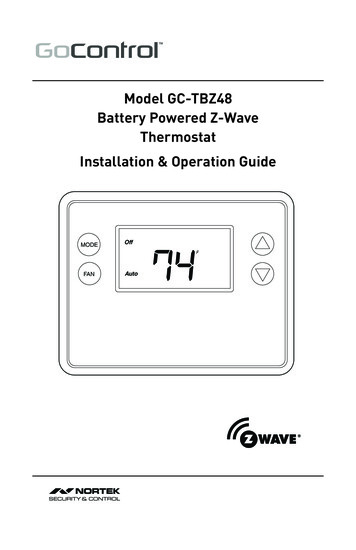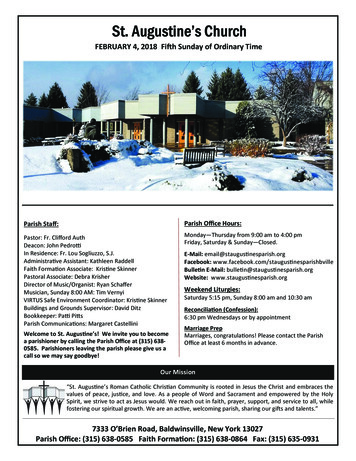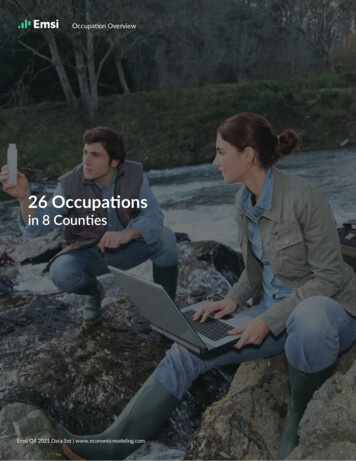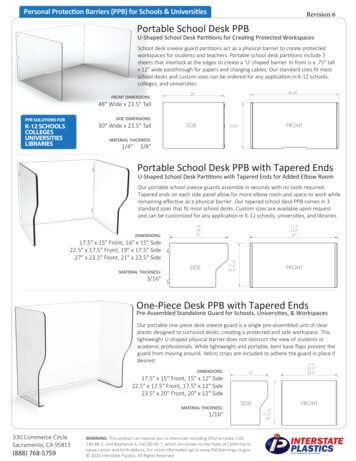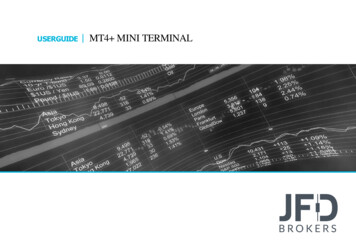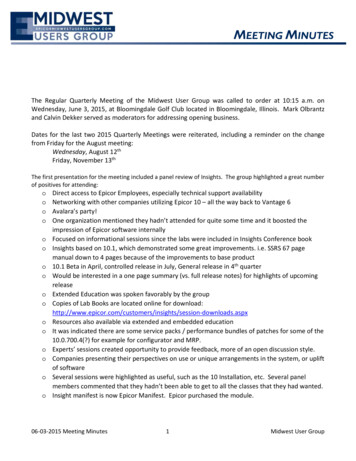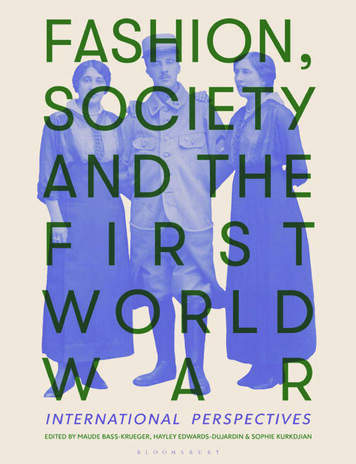
Transcription
Fashion, Society, and theFirst World Wari
ii
Fashion, Society, and theFirst World WarInternational PerspectivesEdited byMaude Bass-Krueger,Hayley Edwards-Dujardin,and Sophie Kurkdjianiii
BLOOMSBURY VISUAL ARTSBloomsbury Publishing Plc50 Bedford Square, London, WC1B 3DP, UK1385 Broadway, New York, NY 10018, USA29 Earlsfort Terrace, Dublin 2, IrelandBLOOMSBURY, BLOOMSBURY VISUAL ARTS and the Diana logo are trademarks of Bloomsbury Publishing PlcFirst published in Great Britain 2021Selection, editorial matter, Introduction Maude Bass-Krueger, Hayley Edwards-Dujardin, and Sophie Kurkdjian, 2021Individual chapters their Authors, 2021Maude Bass-Krueger, Hayley Edwards-Dujardin, and Sophie Kurkdjian have asserted their right under the Copyright,Designs and Patents Act, 1988, to be identified as Editors of this work.For legal purposes the Acknowledgments on p. xiii constitute an extension of this copyright page.Cover design by Adriana BriosoCover image: Two women wearing a Poiret military coat, c.1915. Postcard from authors’ personal collection.This work is published subject to a Creative Commons Attribution Non-commercial No Derivatives Licence.You may share this work for non-commercial purposes only, provided you give attribution to thecopyright holder and the publisherBloomsbury Publishing Plc does not have any control over, or responsibility for, any third-party websitesreferred to or in this book. All internet addresses given in this book were correct at the time of going to press.The author and publisher regret any inconvenience caused if addresses have changed or sites have ceased to exist,but can accept no responsibility for any such changes.A catalogue record for this book is available from the British Library.A catalog record for this book is available from the Library of Congress.ISBN: HB:978-1-3501-1986-4ePDF: 978-1-3501-1987-1eBook: 978-1-3501-1988-8Typeset by RefineCatch Limited, Bungay, SuffolkTo find out more about our authors and books visit www.bloomsbury.com and sign up for our newsletters.iv
To our colleagues, friends, families, and everyone in between.v
vi
ContentsList of illustrations xAcknowledgments xiiiA note on translations xvTimeline xviIntroduction 1Maude Bass-Krueger and Sophie KurkdjianPart One The reconfiguration of the international couture industry151Wartime marketing of Parisian haute couture in the United States, 1914–17Mary Lynn Stewart172Boué Sœurs: “Compelled by the War”Waleria Dorogova3“Gladdening the hearts of warriors”: The relationship between Lucile’s romanticfashions and morale in the First World War 46Georgina Ripley4Die Kriegskrinoline: A feminine fashion between past and futureBirgit Haase5Fashion in Belgium during the First World War and the case of Norine CoutureNele Bernheim295972vii
viiiContentsPart Two The materiality of wartime fashion and textile industries896Dressed to quill: The origin and significance of the feathered showgirl inFirst World War Paris 91Emily Brayshaw7Between fashion and folk: Dress practices in Alsace during the First World WarSara Hume8The lace industry in France and Belgium during the First World WarMarguerite Coppens9Industrial and homemade clothing production in the Netherlands: A neutralcountry during the First World War 134Marta Kargól10812210 Wartime fabrics in the historical archives of Como weavers and in the collections ofthe Fondazione Antonio Ratti 151Margherita RosinaPart Three Problematic uniforms: Male and female experiences andsecondhand trade networks 16311 “Breeched, booted, and cropped”: A dress historical analysis of the uniform worn bymembers of Britain’s Women’s Land Army, 1917–19 165Amy de la Haye12 The French home front in 1914–18: An investigation into female workwearJérémie Brucker18213 Rushing to suit up: French aviation’s adjustment to wartime uniforms, 1914–16Guillaume de Syon14 The spoils of war: Use and transformations of secondhand uniforms during theFirst World War in France 208Manuel Charpy197
ixContentsPart Four Fashion in print: Questions of national fashion and gender15 The gentleman turned “enemy”: Men’s fashion in the Hungarian press, 1914–18Zsolt Mészáros16 The politics of fashion: German fashion writings in times of warBurcu Dogramaci22923124617 The Italian fashion magazine Margherita: The war, women, and the call for a “ModaItaliana,” 1914–18 260Enrica Morini18 Le Flambeau’s fashion discourse during the First World War: Towards a retrogradefemininity? 272Nigel Lezama19 Is beauty useless? Fashion, gender, and British wartime society in Punch Magazine,1915 288Andrea KollnitzNotes on contributors 309Index 315
Illustrations0.1 “Expansion of the War—Dates on which Declarations of War were made.”0.2 Two women and a French soldier wearing a Poiret military coat, c. 1915.xxii62.1 Baronne Jeanne d’Etreillis and Sylvie Montegut with their children Mounette andPhilippe in the park of Château de Maison Rouge, Gagny, summer 1917. c. 1915.302.2 “Robe Corbeau,” taffeta and velvet dress with “new draped skirt and waistcoat effect.”332.3 “Ma Patrie,” Summer Collection, 1916, pencil, ink, and watercolor sketch forpresentation purposes, stamped “Boué Sœurs Ltd., 9, Rue de la Paix, Paris.”362.4 Mannequin wearing the “Manette” model, winter 1919.382.5 Witold Gordon, Boué Sœurs advertisement, Newport Casino program, 1917.393.1 “Carresaute,” Lucile evening dress. Blue silk chiffon, lace, and metallic embroidery,London, 1905.483.2 Woman’s evening dress of shot silk, with gold embroidered net and passementerie,by Lucile Ltd, Paris, France, 1918543.3 Page from Lucile sample album book of fashion designs of women’s clothes,Great Britain, 1905.544.1 Thomas Theodor Heine, caricature, “Die enttäuschte Pariserin” (The disappointedParisian), Simplicissimus, 1916.604.2 Annie Offterdinger, Modebild II (Two dancing women), 1916. Lithograph publishedin Zeit-Echo: Kriegstagebuch der Künstler, 1916.635.1 Elvira De Baets sent photographs of herself in fashionable outfits to her fiancé, keptprisoner in Soltau, Germany, winter 1914.755.2 Norine Deschryver and Paul-Gustave Van Hecke in their workshop, c. 1919.765.3 The Belgian fashion magazine Modes Élégantes, October 1, 1915.795.4 René Magritte, poster design for Norine, 1926.816.1 Quelques fantasies typiques de la mode d’hiver 1913 (Some trimmings typical ofwinter 1913 fashions), 1914.6.2 Leonetto Cappiello, “Pupazzi var Cappiello,” Fantasio, 1918.x98101
Illustrationsxi7.1 Henri Bacher, 22 Novembre 1918: L’Entrée glorieuse des troupes Françaises àStrasbourg, 1919.1097.2 Hansi, Pages d’Album, c. 1915.1147.3 Leven and Lemonier, Alsace interprété par Mme Réjane, 1916.1168.1 Propaganda photo for Amies de la dentelle, c. 1915. Postcard.1278.2 War Lace depicting the rooster, symbol of France. Volant in Malines lace.1288.3 War Lace depicting allies’ banners. Needle-lace fan sheet. Dated and signed, 1915,Fernand Khnopff.1288.4 Paul Mussche, Comité de la dentelle, 1915, pl. 2. Catalogue of lace pieces offered for sale.1299.1 Fashion illustration. Gracieuse, no. 7: 16/5 (1916).1399.2 Fashion illustration. Gracieuse, no. 8: 16/3 (1915).1409.3 Knitting for soldiers. Gracieuse, no. 19: 13 (1914).1429.4 Knitting for soldiers. Gracieuse, no. 20: 9 (1917).14310.1 Lyon, Boisson & Fesquet, Sample of Taffetas rayé, 1915.15610.2 Lyon, Boisson & Fesquet, Sample of Poult de soie rayé, 1914.15710.3 Lyon (?), Fragment of ribbon, Gros de Tour broché, 1914.15911.1 Photographic portrait of member of Britain’s Women’s Land Army, postcard, 1917–19.16811.2 Satirical postcard, 1917–19.17111.3 Photographic postcard. A group of dairy workers (they wear white overalls).17611.4 Studio portrait of a uniformed member of Britain’s Women’s Land Army, 1917–19.Orphan photograph.17712.1 Women replacing male café waiters, 1914–18.18612.2 War-themed calendar, 1st year, August 1914–July 1915.18712.3 “La Françoise,” trademark, May 16, 1916.19012.4 Drawing by Jean Villemot, “Les Usines de guerre.”19213.1 The mix of uniforms of this military class at the Avord training airfield reflects thevariety of arms that contributed flyers to the nascent French Air Force.19913.2 Pilot Adolphe Pégoud (1889–1915) sports a mix of clothing, combining leather pantswith a leather coat over his military tunic in 1914, at the start of hostilities.20113.3 A postcard showing a typical reconnaissance crew wearing a combination of leatherpants and fur coats or goat skins, c. 1915.20213.4 By the end of the war, two air force uniforms existed, one light blue, worn byFrench top ace René Fonck at the victory parade on July 14, 1919, and the otherdark blue (almost black).20414.1 “Le Marchand d’habits militaires” (The military clothing merchant), 1914.21014.2 “Le tricot du combattant” (The soldier’s knit), 1914.214
xiiIllustrations14.3 Clothing distribution on the Front on the initiative of La Revue hebdomadaire.21514.4 The charity “Les Vêtements pour les combattants” (Clothing for soldiers).21614.5 Local leaders in European secondhand clothing. A common representation prewar, itdisappeared with the involvement of Senegalese skirmishers.22115.1 Cover illustration, “A nők kedvence” (The ladies’ sweetheart), artist: Dezső Bér.23315.2 Advertisement for Dr. Jutassy’s cosmetic brand, Színházi Élet.23515.3 At the Budapest horse races, 1917.24016.1 Pamphlet cover, Hermann Muthesius, Die Zukunft der deutschen Form (The Futureof German Form).24716.2 Book cover, Hermann Muthesius, Der Deutsche nach dem Kriege (The Germanafter the War).24816.3 Book cover, Norbert Stern, Die Weltpolitik der Weltmode (Global Politics ofGlobal Fashion).24918.1 Cover of Le Flambeau’s first issue, May 29, 1915.27318.2 Louise Faure-Favier’s first fashion column, Le Flambeau, May 29, 1915.27418.3 Camille Duguet’s fashion column, Le Flambeau, August 28, 1915.27818.4 Camille Duguet’s fashion column, Le Flambeau, October 9, 1915.27918.5 Jeanne Tournier’s first fashion column, Le Flambeau, November 13, 1915.28119.1 Arthur Wallis Mills, “More people we should like to see interned,” Punch, March 24, 1915. 29319.2 Lewis Baumer, “Well, Madam, we sell a good many of both . . .,” Punch, August 18, 1915.29719.3 Lewis Baumer, “How Sir Benjamin Goldmore and his junior clerk . . .,” Punch,April 28, 1915.301
AcknowledgmentsThe process of gathering the papers and editing this volume has taken five years. We are immenselygrateful to all those who supported us throughout this process, and particularly to our authors, whosepatience with us has been tremendous. We received grants from the Mission du centenaire de laPremière Guerre mondiale for the publication of this book. At the Mission du centenaire, we wouldlike to thank Joseph Zimet, Quentin Tissot, and Richard Holding for their generosity and continuedsupport of our work. Funds from Bijzonder Onderzoeksfonds (BOF) at Ghent University have alsohelped cover related publication costs.Procuring the image rights has been a labor of love by our authors. We thank them, as well as JackGlover Gun at the Victoria & Albert Museum (V&A) for assisting us with rights for the photos fromthat collection. The sharp eyes and precise corrections of Joannes van den Maagdenberg and MathisVanhee were of indispensable help in the formatting of all the notes and references. We are indebtedto Frances Arnold, our editorial director, for providing unwavering support throughout this process.We would particularly like to thank her, as well as Yvonne Thouroude and Rebecca Hamilton, editorialassistants at Bloomsbury.Amy de la Haye has provided unfailing support throughout this project. She very generously tookthe time to help us select, edit, and revise a first round of papers. In a gesture of professionalgraciousness, she bowed out from being named as co-editor in order to allow us, three young scholars,to come forward under our own names. She effectively sent the elevator back down, as the saying goes,and for this we are grateful.These papers were originally presented at a conference organized by Maude Bass-Krueger andSophie Kurkdjian as part of the seminar, “Histoire et Mode” at the Institut d’histoire du temps présent(IHTP-CNRS). At the time, the seminar was run by Sophie Kurkdjian and Thierry Maillet, who hadtaken over from its formidable founder, Dominique Veillon, assisted by Eléonore Testa. The IHTP hasbeen a strong support for the seminar and its conferences since its foundation in 2001. We would liketo thank Christian Delage, Christian Ingrao, and Henry Rousso at the IHTP.The conference, “Fashion, Dress, and Society in Europe during World War I,” was held in Paris onDecember 12–13, 2014. It was co-hosted by Dominique Veillon, Lou Taylor, and Adhelheid Rasche.xiii
xivAcknowledgmentsWe would like to thank them for their mentorship and their encouragement. The careers of youngfashion scholars stand on their shoulders. We are grateful for their friendship throughout the years.The conference received financial support from L’Oréal Recherche et Innovation, thanks to IsabelleWalter. We thank the Institut français de la mode, particularly Dominique Jacomet, David Zajtmann,and Lucas Delattre, for graciously lending us their space to organize our conference. Alexane Querrecwas the graphic designer of the conference program.Above all, we would like to thank everyone who spoke at the 2014 Paris conference. The two-dayconference was enriching in more ways than one: not only did we hear about fascinating new research,but we also made friends and colleagues, whose continued presence in our lives has widenedour networks and strengthened our own work. We would like to thank: Nuria Aragonès, Ana Balda,Beatrice Behlen, Ulrika Berglund, Nele Bernheim, Muriel Berthou Crestey, Cally Blackman, EmilyBrayshaw, Maria Carlgren, Laura Casal-Valls, Manuel Charpy, Katy Conover, Marguerite Coppens,Ilaria Coser, Jennifer Daley, Gillian Davies, Burcu Dogramaci, Lourdes Font, Holly Grout, DidierGrumbach, Birgit Haase, Barton C. Hacker, Sara Hume, Stéphane Jacques-Addade, Catherine JoinDieterle, Marta Kargól, Andrea Kollnitz, Regina Lee Blaszczyk, Nigel Lezama, Thierry Maillet, ChryssaMantaka, Marie Mcloughlin, Zsolt Mészáros, Alisa Miller, Enrica Morini, Anna Novikov, LewisOrchard, Alexandra Palmer, Victoria Pass, Emmanuelle Polle, Alan Price, Adelheid Rasche, GeorginaRipley, Jennifer Roberts, Margherita Rosina, Victoria Rovine, June Rowe, Suzanne Rowland, Änne Söll,Mary Lynn Stewart, Guillaume de Syon, Lou Taylor, Patricia Tilburg, Elena Trencheva, DominiqueVeillon, Margaret Vining, Eva Maria Zangl, Johanna Zanon, and Steven Zdatny.Maude Bass-Krueger, Hayley Edwards-Dujardin, and Sophie Kurkdjian
A Note on TranslationsThe texts of Jérémie Brucker, Manuel Charpy, Marguerite Coppens, Marta Kargól, Zsolt Mészáros, andEnrica Morini were translated from French by Tristan Bass-Krueger. Burcu Dogramaci’s text wastranslated from German by Hayley B. Haupt. All citations and quotes within articles and footnotes aretranslated from their original language by the author, unless otherwise specified. The translation ofnames of associations, syndicates, unions, and magazines were done by the editors.xv
TimelineTimeline of social and political historyTimeline of fashion and women’s history1914JUNE 28: Assassination of Archduke Franz Ferdinandof Austria. Austria suspects Serbia is responsible.JULY 28: Austria-Hungary declares war on Serbia,beginning the First World War.JULY 31: Full mobilization is announced in AustriaHungary.JULY: Suffragette demonstration in Paris, with 6,000women led by Caroline Rémy de Guebhard, bestknown under the pen name Séverine.AUGUST 1: General mobilization order in France andGermany.AUGUST: Publication of the last issue of La Gazettedu Bon Ton, edited by Lucien Vogel.AUGUST 3: Germany declares war on France. Italy,part of the Triple Alliance with Germany and AustriaHungary, remains neutral.AUGUST: Decree closing entertainmentestablishments such as theaters and cinemas in Paris.AUGUST 4: The German army Marches on neutral Belgium.AUGUST 10: Austria-Hungary invades Russia.END OF AUGUST: Beginning of the exodus ofBelgians to France, England, and the Netherlands(which remains neutral during the war).AUGUST 1 23: Presentation of new Parisian couturecollections with the “crinoline” silhouette.AUGUST 2: Mobilization of fashion designer JeanPatou to the rank of captain, on a temporary basis, ofthe 269th infantry regiment.AUGUST 4: Mobilization of the couturier Paul Poiret,assigned to the 119th infantry regiment as a tailor.AUGUST 7: René Viviani’s “Call to Women,” an appealto peasant women to contribute to the war effort inFrance.SEPTEMBER 2: The French government settles inBordeaux.SEPTEMBER 5 12: Beginning of the First Battle of theMarne. Allied forces halt German advance into France.SEPTEMBER 20: German troops bombard Reims.SEPTEMBER: Creation of the privately-run relieforganization Comité national de secours et d’alimentation(National Committee for Food and Relief) in Brussels.xvi
TimelineTimeline of social and political historyTimeline of fashion and women’s historyOCTOBER 31: First Battle of Ypres. German and Alliedtroops are unable to win a decisive victory.OCTOBER 14: Successful presentation of BouéSœurs collections in New York.xviiNOVEMBER 5: Britain and France declare war on theOttoman Empire.DECEMBER 2: End of maneuver warfare andbeginning of trench warfare.DECEMBER 21: The Chambre Syndicale de laCouture Parisienne is dissolved so as to expel foreigncouture houses.DECEMBER 8: French government returns to Paris.DECEMBER: The Poiret greatcoat is issued to replacethe 1877 coats worn by soldiers.DECEMBER 15: Launch of the great Champagneoffensive.DECEMBER: Some theaters resume activity.1915JANUARY: German zeppelin raids on Great Britainbegin, bringing the war home to British civilians.JANUARY: French women begin to take up jobspreviously reserved for men (public transportation,postal delivery, etc.).FEBRUARY 16: Champagne offensive.FEBRUARY: The Germans try to start their ownfashion industry.FEBRUARY 18: Germany begins naval blockade ofGreat Britain.MARCH 7: Beginning of the controversy about theFrench fashion designer Christoph Drecoll’snationality.APRIL 22: First successful use of toxic gas by theGermans. By the end of the war, both Allied and CentralPowers will have used chemical weapons.APRIL 7: The French couturiers Boué Sœurs open anAmerican branch of their couture house in New York.APRIL 24: Beginning of the Armenian genocideperpetrated by the Turks.APRIL 25: Allied forces land on the Gallipoli Peninsulain the Ottoman Empire.MAY 3: Italy withdraws from the Triple Alliance.MAY 7: German submarine sinks the British passengerliner Lusitania during crossing from New York toLiverpool, England, killing 128 Americans.MAY 23: Italy declares war on Austria-Hungary,entering the First World War on the side of the Allies.MAY 5: The Chambre syndicale de la CoutureParisienne is re-established without foreign couturiersor funding.MAY: Paul-Gustave Van Hecke and HonorineDeschryver open their couture house “CoutureNorine” in Brussels, Belgium.JUNE: Parisian fashion designers exhibit their modelsat the Panama Pacific International Exposition in SanFrancisco.
xviiiTimelineTimeline of social and political historyTimeline of fashion and women’s historyJULY 1: Decision to grant leave of ten days to all Frenchcombatants.JULY: Launch of Le Style Parisien by publisher LucienVogel.JULY 15: Gabrielle Chanel opens a couture boutiquein Biarritz (after opening a hat shop in Paris in 1910and another in Deauville in 1913).AUGUST: Double French-English issue of the LaGazette du Bon Ton published by Lucien Vogel andCondé Nast on the occasion of the Panama PacificInternational Exposition in San Francisco.OCTOBER 6: A combined force of Austro-Hungariansand Germans (and later Bulgarians) invade Serbia.OCTOBER: The London couturière Lady DuffGordon opens a branch of her couture house LucileLtd in Chicago.DECEMBER 20: Beginning of the evacuation of Alliedtroops in the Dardanelles.NOVEMBER: Organisation of the “Fête Parisienne” inNew York, a charity event and play by Bernard Boutetde Monvel to support the French couture industry.NOVEMBER: The metallurgical industry begins torecruit women (munitionnettes) in France.1916FEBRUARY 21–DECEMBER 15: Germany begins theattack on Verdun, leading to the Battle of Verdun. TheBattle ends with 550,000 French and 450,000 Germancasualties.FEBRUARY: Foire de Lyon (Lyon Fair).APRIL: Launch of the newspaper Les Élégancesparisiennes under the direction of Lucien Vogel at theHachette Publishing House.MAY 16: Sykes-Picot Agreement, a secret treatybetween the UK and France to divide spheres ofinfluence in the Ottoman Empire.MAY and JULY: Les Élégances parisiennes presents thefirst jersey suits by “Gabrielle Channel” (sic).MAY 31: Naval Battle of Jutland takes place betweenBritish and German fleets. Both sides declare victoryover the largest naval battle of the war.JUNE 5: Arab nationalists revolt against Ottoman rule.JULY 1–NOVEMBER 18: Beginning of the Battle ofthe Somme, an Allied offensive.JULY 18: In France, the Committee for Female Laborasks the Minister of Armaments to ensure thatindustries provide workers appropriate work wear.OCTOBER 1: English Vogue publishes “Channel”models (sic).NOVEMBER 7: Woodrow Wilson is re-electedPresident of the United States.NOVEMBER: In Amsterdam, large demonstrations ofwomen demand the right to vote.
TimelineTimeline of social and political historyxixTimeline of fashion and women’s history1917JANUARY: Intense cold and worsening food and coalshortages in France.In Great Britain, creation of the Women’s Land Army(WLA) to support British farming and agriculture.Women, known as Land Girls, replace male farmerswho had gone to war.JANUARY: Launch of the barrel silhouette in LesÉlégances parisiennes. Ban on evening dresses withlow-cut necklines at the Opera and in Parisiantheaters.FEBRUARY: Establishment of the Queen Mary’s ArmyAuxiliary Corps (QMAAC) in Great Britain allowingBritish women to join the British Army.FEBRUARY: Paul Poiret opens a “Poiret Incorporated”branch in New York with the goal of selling ready-towear clothing.FEBRUARY: US severs diplomatic relations withGermany after Germany resumes its campaign ofunrestricted submarine warfare.FEBRUARY: Callots Sœurs, Chéruit, Edouard, Lanvin,Paquin, Poiret, Rodier, and Worth register theirmodels with the French Labour Court to countereventual counterfeiting.MARCH 1: British intelligence intercept theZimmermann Telegram, a secret communication fromGermany proposing an alliance with Mexico should theUnited States enter the First World War.MARCH 5: Creation of the Imperial War Museum inLondon.MARCH 8: Beginning of the February revolution inRussia.MARCH 15: Abdication of Nicolas II of Russia.APRIL 6: The United States declares war on Germany.APRIL 16: Offensive of the Chemin des Dames (TheSecond Battle of the Aisne).MAY 4: Mutinies begin in the French army.MAY: French fashion exhibition organized in Madridby the Syndicat de Défense de la Grande couturefrançaise (included Beer, Doeuillet, Jenny, Lanvin,Worth).MAY 11: Seamstress’ strike in Paris initiated by theworkers of the Jenny couture house.JUNE: American combat forces arrive in France.JUNE 7: Parisian seamstresses’ demands are met andthey receive the “English Week” and a cost-of-livingallowance.AUGUST: US regulations impose textile lengthrestrictions beyond 4.5 meters per dress.AUGUST: Jeanne Paquin is elected new director ofthe Chambre Syndicale, taking over the position ofJean Aine-Montaillé. She remains in the position forthree years.
xxTimelineTimeline of social and political historyTimeline of fashion and women’s historySEPTEMBER: Poiret appointed head of the Army’sregimental tailors. The French Sewing Union assuresthe government that the length of the wool dresseswill not exceed 4.3 meters.OCTOBER 24: Chief General in charge of the FrenchArmies Philippe Pétain’s counteroffensive at Chemindes Dames.OCTOBER: The US government bans the import ofall wool dresses if the fabric blend is comprised of toomuch wool. American factories must reserve their rawmaterials for the army.NOVEMBER 2: Balfour Declaration by the Britishgovernment, announcing support for the establishmentof a national home for the Jewish people in Palestine.NOVEMBER: Implementation of a “national fashion”in France.NOVEMBER 6: October Revolution in Russia.Vladimir Lenin and the Bolsheviks assume completecontrol over the new Soviet Russian state.NOVEMBER 16: Georges Clémenceau named PrimeMinister of France.DECEMBER 9: The British capture Jerusalem from theOttomans.DECEMBER 15: Armistice between Russian andCentral Powers.1918JANUARY 8: US President Woodrow Wilson delivershis Fourteen Points address, outlining his vision for astable peace.FEBRUARY 23: Distribution of general food cards inFrance.MARCH 3: Treaty of Brest-Litovsk between the newBolshevik government of Russia and the Central Powers(German Empire, Austria-Hungary, Bulgaria, and theOttoman Empire), ends Russia’s participation in theFirst World War.MARCH 8: Camp Funston at Fort Riley, Kansas firstreports cases of influenza. The disease spreads overseasto the Western Front. Over the next year, this “Spanishflu” kills 20 million worldwide.JULY 15: Beginning of the Second Battle of the Marne.JULY 17: The Bolsheviks execute Nicolas II of Russiaand his family.JULY 18 AUGUST 6: Aisne-Marne Offensive marks amajor turning point in the fighting on the WesternFront.FEBRUARY 6: English women over the age of 30obtain the right to vote.
TimelineTimeline of social and political historyxxiTimeline of fashion and women’s historySEPTEMBER 26: Meuse-Argonne offensive, the largestoffensive in US history, plays a major role in bringingabout an end to the war.OCTOBER 23–NOVEMBER 3: Battle of VittorioVenet. Austro-Hungarian forces are defeated by theItalian Army, ending the war on the Italian Front andushering in the final dissolution of the AustroHungarian Empire.NOVEMBER 1: Austrian women obtain the rightto vote.NOVEMBER 9: Abdication of William II, and the endof the German Empire. German Republic (later theWeimar Republic) proclaimed.NOVEMBER 11: Armistice between Germany and theAllies.NOVEMBER 30: German women obtain the rightto vote.NOVEMBER 22: The French forces enter Alsace afterthe German defeat.DECEMBER: Allied troops move into Germany andbegin Occupation.DECEMBER: Chanel expands and opens a coutureboutique at 31, rue Cambon, Paris.1919FEBRUARY 14: Allied nations at the Paris PeaceConference propose establishment of the League ofNations to promote international cooperation.JUNE 19: Germany is forced to sign the Treaty ofVersailles. Germany cedes Alsace-Lorraine to France,recognizes Belgian sovereignty, disarms and agrees topay war reparations. US Senate refuses to ratify theTreaty of Versailles, thus preventing the country fromjoining the League of Nations.MARCH 20: Demobilized, Jean Patou presents hisfirst postwar collection.AUGUST 10: Treaty of Sèvres imposed by the Allies onthe Ottoman Empire. The treaty was designed toliquidate the Ottoman Empire and abolish Turkishsovereignty.SEPTEMBER 28: Dutch women obtain the rightto vote.MAY 20: Members of the European Parliament adoptfemale suffrage, but the French Senators reject it inNovember 1922.
xxiiFigure 0.1 “Expansion of the War—Dates on which Declarations of War were made.” Map from The Story of the Great War, vol. 5, Francis JosephReynolds, Allen Leon Churchill, and Francis Trevelyan Miller, eds. (New York: P.F. Collier & Sons, 1916), front insert.
IntroductionMaude Bass-Krueger and Sophie KurkdjianInserting the international dimensioninto First World War fashionThis book examines fashion during the First World War from an international perspective. Fashion isaddressed broadly: the essays in this book cover the garment, textile, and accessory trade—its objects,producers, consumers, and venues for dissemination—as well as fashion as an expression of personalidentity. Earlier dress historians had written the First World War out of the history of fashion’sevolution in the early twentieth century, while historians had written fashion out of socioculturalhistories of the Great War. A few scholars have addressed this lacuna in the past few years, but primarilythrough a national perspective—recent monographs and exhibitions have addressed French, British,German, or American fashion during the First World War, for instance.1 This book expands on theirbody of work, while challenging us to examine the international ties that bound together globalfashion networks and fashion practices between 1914 and 1918.The war altered the business of fashion on a national and international scale. The authors writingin this volume argue that the changes that occurred in the fashionable silhouette, while set in motionin the 1910s, were fixed into place during the war. Their essays highlight how the war restructured theinternational couture industry—not by decentering the axis away from Paris, but by finding a neweconomic balance with the US. “Problems” with the supposed reconfigurations of gender, which cameto a fore in the interwar period, were rooted in new wartime fashion, workwear, and uniforms for menand for women. Fashion magazines, far from ceasing publication during the war, as some historianshave suggested, honed their discourse during the war in order to guide consumers and address societalanxiety around new fashion practices. Read together, the essays in this volume broaden ourunderstanding of the international networks of wartime fashion trade and dress practices, while alsosignificantly adding to our knowledge of how fashion operated on national levels during a period ofcomplex political alliances (Figure 0.1).1
2Fashion, Society, and the First World WarThe papers weave fascinating connections between one another and the countries they address,which include France and its colonies, the US, Great Britain, Italy, Belgium, the Netherlands, Germany,and Hungary. Many
18.2 Louise Faure-Favier's fi rst fashion column, Le Flambeau, May 29, 1915. 274 18.3 Camille Duguet's fashion column, Le Flambeau, August 28, 1915. 278 18.4 Camille Duguet's fashion column, Le Flambeau, October 9, 1915. 279 18.5 Jeanne Tournier's fi rst fashion column, Le Flambeau, November 13, 1915. 281
